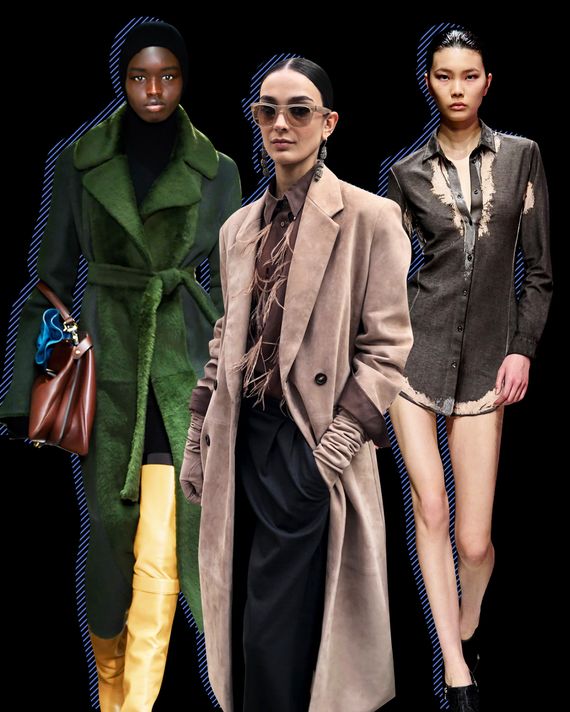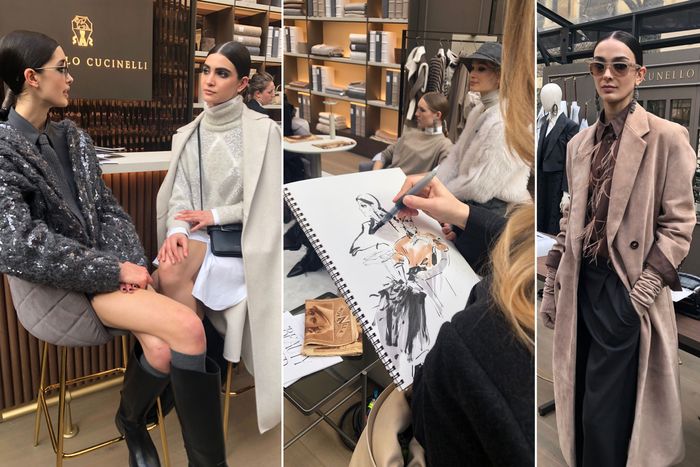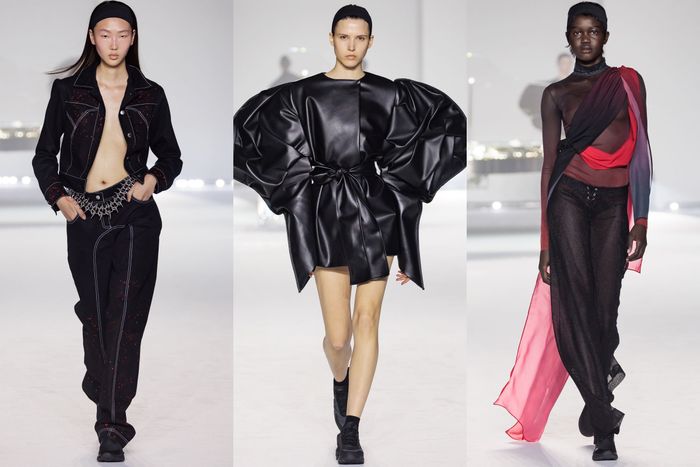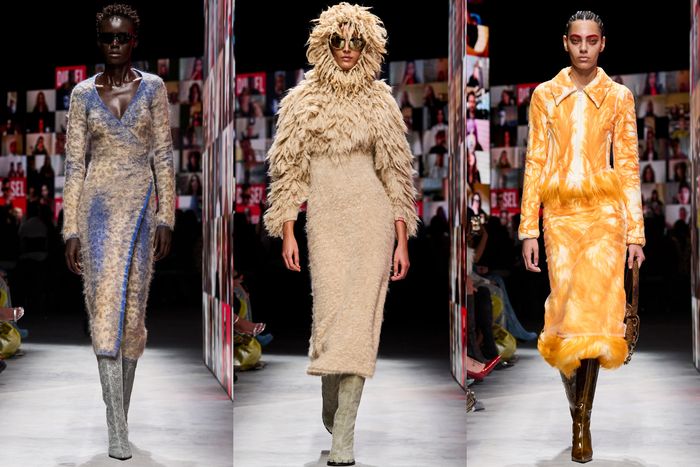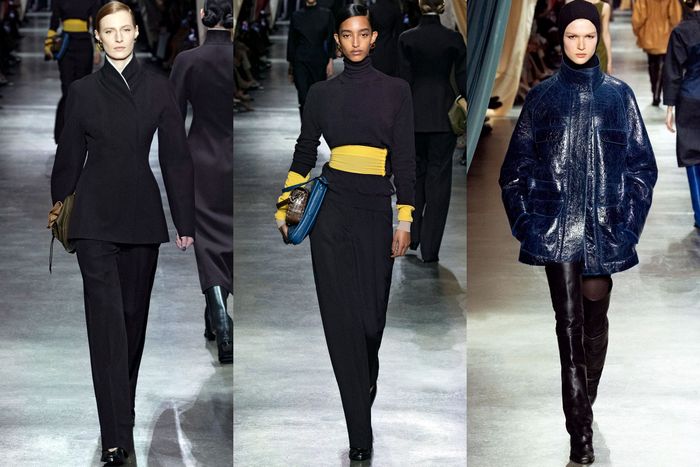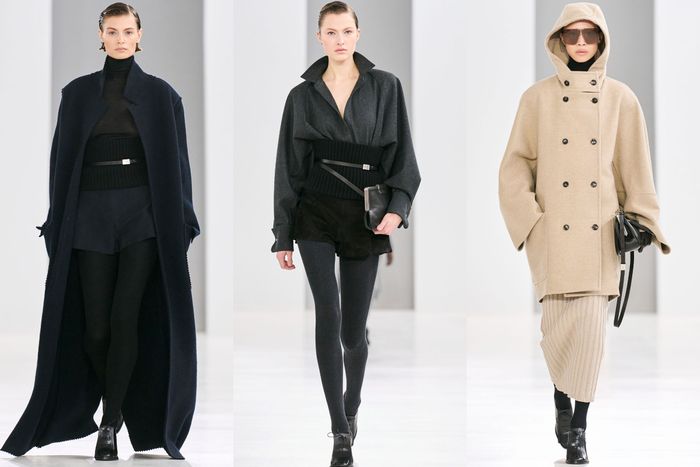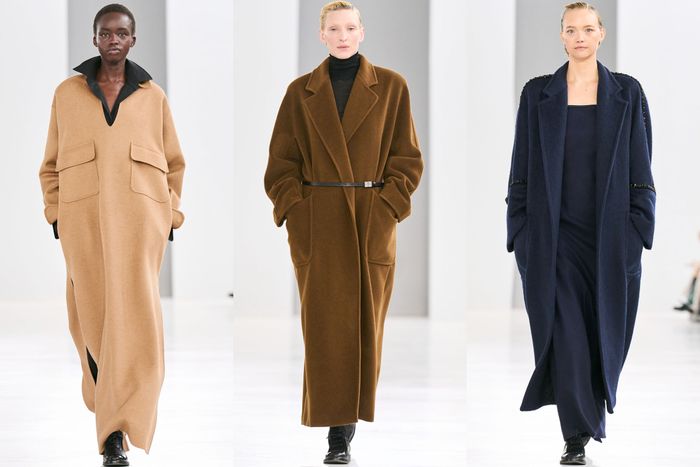Photo: by The Cut; Photos: Getty Images, Cathy Horyn, Courtesy of Diesel
The Milan commercial juggernaut has begun, and it’s a reminder (as if we need it) that shows are rarely about exciting fashion alone. They’re also about creating a sense of belonging and community, and, of course, fueling one’s personal brand.
On Wednesday, the dapper, inexhaustibly charming Brunello Cucinelli served Veuve Clicquot and practical wisdom to hundreds of journalists and retailers flooding into a greenhouse erected in the courtyard of his company’s Milan offices. The weather has been sunny but chilly, and the temperature suddenly rose when you entered the plant-strewn room. In several vignettes meant to evoke a cafe or library or a newspaper office — apparently a very slow paper; the typewriters were manual — models lounged about in layered knits, shearling vests, and tailored suits.
Brunello Cucinelli
Photo: Cathy Horyn
You can understand why Cucinelli prefers the term gentle luxury over quiet luxury, since there is usually a metallic thread or embroidery to jazz up his expensively plain sportswear. But he is really splitting hairs. The Cucinelli brand, and the source of his success, is about a lifestyle, its roots more earnestly bourgeois than callous and cold high-fashion.
Yoshiki has achieved an international reputation as a rock and classical musician; and in Japan, he’s known for his clothing brand Yoshikimono, which draws on his family’s connection to kimono production. The 58-year-old performer and entrepreneur now wants to add “high fashion” to his résumé, which also includes wine-making and a recent collaboration with Baccarat.
Yoshiki
Photo: Gaspar J. Ruiz Lindberg/ Courtesy of Maison Yoshiki
Not surprisingly, his mostly black clothing — sleek, low-rise trousers; coats and fitted jackets with faux-fur trims; satin or jersey dresses sliced open over the body or sprouting futuristic wings — have a performance quality. Maison Yoshiki’s clothes are all made in Europe and owe something to the Mugler style. For the finale, Yoshiki played two pieces on a clear acrylic piano, including the aria “Nessun dorma” from Puccini’s “Turandot.” He seemed utterly chill about his ability to be a designer, which is perhaps not surprising at all.
Diesel
Photo: Courtesy of Diesel
But when it comes to combining a contemporary feeling of community with great fashion, no one did it better than Glenn Martens of Diesel. His show on Wednesday began 72 hours earlier, when the studio provided open access to the public via cameras. So anyone could watch Martens and his team prepare the show. Then, on the day of the show, about 1,000 individuals worldwide were granted a kind of front-row seat via a live video call. From their bedrooms, desks, wherever, their faces appeared in grids of faces on giant screens placed around the show venue. Most people watched soberly and intently, but many others used the moment to show their partially covered boobs, apply makeup, display their pets, and act like maniacs.
Diesel
Photo: Courtesy of Diesel
It was genius. Meanwhile, the models walked in front of the screens, often within inches of the actual audience. So Martens killed many birds with one stone. And if this show had only been a technological advance on public involvement, it would have been a dud. But the clothes were terrific. Martens has introduced a number of techniques at Diesel, including denim and other materials that have been burnt to create new textures and patterns, as well as knits that look weirdly hairy (or matted) and print dresses that are aggressively shredded. But he now has refined many of those ideas, and the results showed.
Fendi
Photo: Courtesy of Fendi
Fendi was subdued and classic. Kim Jones, creative director of the Rome-based house, found his starting point during a random archive search, when he landed on a 1984 Lagerfeld collection. Given the time period, that led to a connection to the British fashion movement known as the New Romantics — a favorite touchstone for Jones. He described the collection to me as “the idea of people dressing up, in a chic way. Which is very much how the Romans dress.”
Fendi
Photo: Courtesy of Fendi
The driving element in this smartly low-key show was the tailoring, which gave a more linear line than a broad-shouldered one. That looks fresh. The palette also felt distinctly Roman — black, cobalt blues, gray, camel, moss green, and a touch of pale yellow — with both Italian and English fabrics. Many designers this season are treating shearling in novel ways, but Jones and the Fendi craftspeople have taken it further. They almost completely shave off the hair and then needle-punched the skin all over, giving it an original feel and weight. Not quite like wool but no longer like shearling, either.
Max Mara
Photo: Courtesy of Max Mara
This morning, Max Mara held its fall show in a vast building that looked like a basketball court, and the scene of rows and rows of guests perched on white blocks prompted my colleague Jessica Willis, the Cut’s fashion director, to remark that it looked like a movie of a fashion show.
Well, she wasn’t off the mark. While guests were still standing in the middle of the runway, chatting and so on, a lone model came out of the backstage and started walking. That cleared the decks. Then the rest of the show goes underway.
Max Mara
Photo: Courtesy of Max Mara
The clothes were ultra-chic and plain, beginning with the first look: long, soft-shouldered navy coat over black shorts and black tights. Some of the models even wore black gloves to complete the look, and drive home a sober, and sobering, elegance.
You can read a lot from a fashion show. At a time when many people are concerned about the economy and the future, when there are at least two major military conflicts, and when there is rising childhood poverty in many countries, including the United States, there is a logical reason to present perfectly sound and durable fashion.
Credit: Source link
